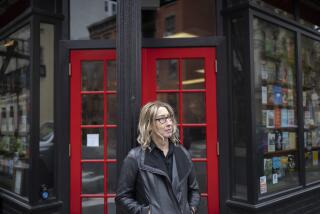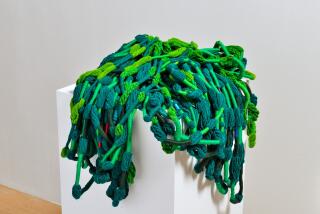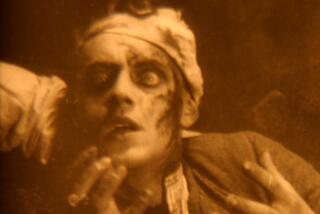Quirky Quilts Donât Leave All in Stitches
SIMI VALLEY â For some, it represents a renaissance within the usually sedate world of quilting. For others, itâs the corruption of a uniquely American pastime.
Whatever it is, a pair of quilts on display at the Ronald Reagan Presidential Library have been removed after a handful of visitors complained that one depicted scenes too violent for such a wholesome medium in such an upright museum and that the other glorified Nazism with a swastika shape stitched together in the colors of the Stars and Stripes.
The quilts were returned to their owners last week at the direction of library Director Mark Hunt, who said he did so to head off any controversy that might tarnish the image of the exhibit organized by the library, âAmerica Remembers: Quilting the 20th Century.â
The exhibit, which opened in April, will run until Oct. 4 and features dozens of quilts depicting everything from a peanut-shaped Jimmy Carter to a stalk of broccoli titled âA Nightmare for George Bush.â
âWe didnât want any sort of controversy to overshadow the exhibit,â Hunt said.
The quilt described as too violent, patched together by 20 seamstresses from Lawrence, Kan., depicts a character named Sunbonnet Sue meeting her end in a number of ways.
In one frame, she is being squashed by a large elephant. In another, she is portrayed as a Heavenâs Gate cultist, lying on a bed and wearing black Nike sneakers with a purple sheet pulled over her body.
In others, she is being attacked by bees and by the Big Bad Wolf; one even shows her as the victim of a drive-by shooting.
âWeâre all pretty surprised by the reaction it got,â said Sarah Fayman, one of the quilters who helped piece together the morbid montage. The group, she said, figured it was time to stop taking the familiar farm girl image so seriously.
âWe thought it was really funny. . . . We still think itâs funny, and I think some people just overreacted a bit,â Fayman said.
The other quilt removed, âThe Spirit of St. Louis,â was created more than 60 years ago in commemoration of Charles Lindberghâs 1927 transatlantic solo flight.
*
Hunt said he did not remember who made the quilt, which displays Lindberghâs single-engine plane with a propeller fashioned from red, white and blue fabrics.
The artist intended to give the quilt to her son as a graduation present, but stowed it away in a cedar chest because she wasnât happy with the propellerâs swastika shape, he said.
The exhibition organizers decided to use the quilt because it fit with the showâs theme of illustrating how quilting has been used throughout the century as a form of social and political expression.
However, the artist had actually intended to express American pride rather than make a case for Nazism or blaspheme Old Glory, as some of the exhibitâs visitors have charged, library officials and Fayman said.
âAll of this is pretty outrageous, and all of us here are getting a real kick out of it,â Fayman said.
âBut even more seriously, this is really a kind of censorship, because [the quilts] are saying something. . . . Ours is just a parody of a quilt pattern that none of us liked very much, so we thought it would be funny to put her to rest.â
According to Marvin Krakow, a Los Angeles-based civil rights attorney, charges of censorship may be stretching the case a little, since the portion of the library where the exhibit is housed is operated by a private foundation (the archives portion is federally sponsored).
But such institutions need to be careful, Krakow said.
âThe library, in fact, has a 1st Amendment right to display and not display whatever it wants,â he said. âBut libraries such as these, though private, serve a valuable public function, and they need to be careful about choosing what to exhibit based upon what people might think, because that can affect their mission of informing and educating people.â
Although disappointed that her groupâs work will no longer be on display, Fayman said the whole issue may prove to be a blessing in disguise.
âWho knows, with all this publicity, maybe somebody else will want to display it,â she said. âOr even better, maybe somebody will want to give us a lot of money for it.â
More to Read
The biggest entertainment stories
Get our big stories about Hollywood, film, television, music, arts, culture and more right in your inbox as soon as they publish.
You may occasionally receive promotional content from the Los Angeles Times.










